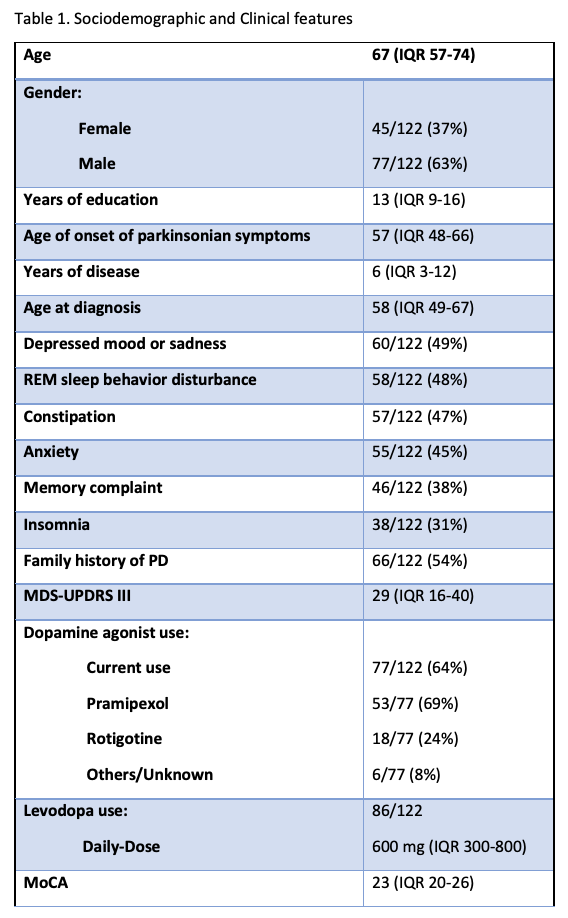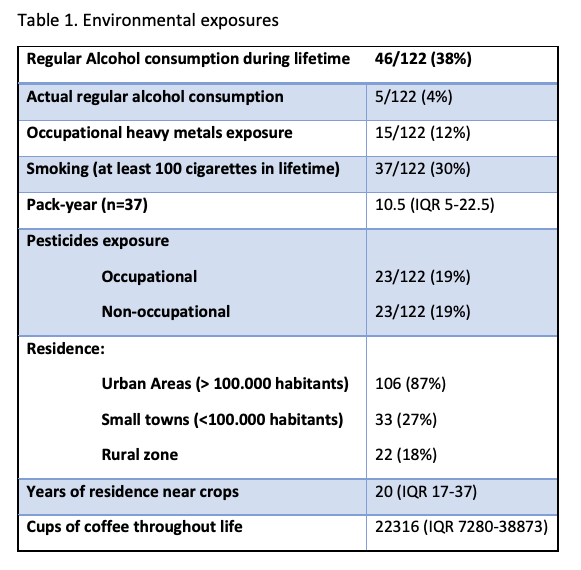Category: Epidemiology
Objective: Describe the clinical phenotype and environmental agents of patients from the Colombian southwestern region with familiar and sporadic Parkinson’s disease in a sample
Background: PD is a multifactorial disorder where genetic susceptibility and epigenetic changes induced by exposures such as pesticides and heavy metals play an important role (1). Southwestern Colombia is an ethnically diverse region where natives, “mestizo” and Afro-American converge (2) with agriculture, mining, illegal-crops fumigation and inbreeding in rural areas (3). There are no studies of clinical and environmental exposures characterization in this region
Method: A cross-sectional study was conducted within the framework of the LARGE-PD consortium. A non-probabilistic sampling was used amongst patients that were evaluated in neurological consult at Fundación Valle del Lili, a high complexity hospital in southwestern Colombia and during medical brigades in small towns. Clinical evaluation, MoCA Test and NMSQuest were used for clinical features. A structured questionnaire was applied for exposures and pedigree was obtained
Results: 122 patients were included. Median age was 67 (57-74), 37% were females. 71% were on early stages (HyY≤2), onset of motor symptoms age was 57 (48-66). 49% reported depressive mood; 48% REM sleep disorder. 54% had family history of Parkinson’s disease. MDS-UPDRS III was 29 (16-40) and MoCA score was 23 (20-26). (table 1). The 22% have lived in rural areas in their life while 27% have lived in small towns. 30% reported have smoked in their life with a median pack-year of 10,5 (5-22,5); 12% worked with heavy metals during their life, with a mean exposition time of 11 years (5,5-22,5). 19% were exposed to occupational pesticides and non-occupational with 5 years (2-15) and 9 years (3-18,75), respectively. (table 2)
Conclusion: Here we present preliminary results. Southwestern Colombia has a high frequency of intrafamilial aggregation of PD (54%) with disease onset before 60 years. Patients reported a several NMS as well as they exhibit an MCI. A considerable portion of the sample has lived in small towns or in rural areas where inbreeding can play an important role in the incidence of the disease. Also, there is an important exposure to pesticides and heavy metals, that can be in relation to the permanency in high-risk rural zones
References: (1) Nandipati, S., & Litvan, I. (2016). Environmental Exposures and Parkinson’s Disease. International journal of environmental research and public health, 13(9), 881. https://doi.org/10.3390/ijerph13090881
(2) Chande, A. T., Nagar, S. D., Rishishwar, L., Mariño-Ramírez, L., Medina-Rivas, M. A., Valderrama-Aguirre, A. E., Jordan, I. K., & Gallo, J. E. (2021). The Impact of Ethnicity and Genetic Ancestry on Disease Prevalence and Risk in Colombia. Frontiers in genetics, 12, 690366. https://doi.org/10.3389/fgene.2021.690366
(3) C. B. Hernández-Rodríguez, A. M. Gutiérrez-Malaxechebarría, and C. A. Zafra-Mejía, “Lead levels in Colombia reported in different environmental matrices,” Ing. Univ., vol. 25, 2021 [Online]. https://doi.org/10.11144/Javeriana.iued25.rlld
To cite this abstract in AMA style:
J. Orozco Velez, H. Clavijo-Moran, D. álvarez-García, I. F Mata, B. Muñoz-Ospina. Environmental exposures and clinical phenotype in a sample of patients with Parkinson’s disease in the southwestern Colombian region: preliminary results [abstract]. Mov Disord. 2022; 37 (suppl 2). https://www.mdsabstracts.org/abstract/environmental-exposures-and-clinical-phenotype-in-a-sample-of-patients-with-parkinsons-disease-in-the-southwestern-colombian-region-preliminary-results/. Accessed April 21, 2025.« Back to 2022 International Congress
MDS Abstracts - https://www.mdsabstracts.org/abstract/environmental-exposures-and-clinical-phenotype-in-a-sample-of-patients-with-parkinsons-disease-in-the-southwestern-colombian-region-preliminary-results/


